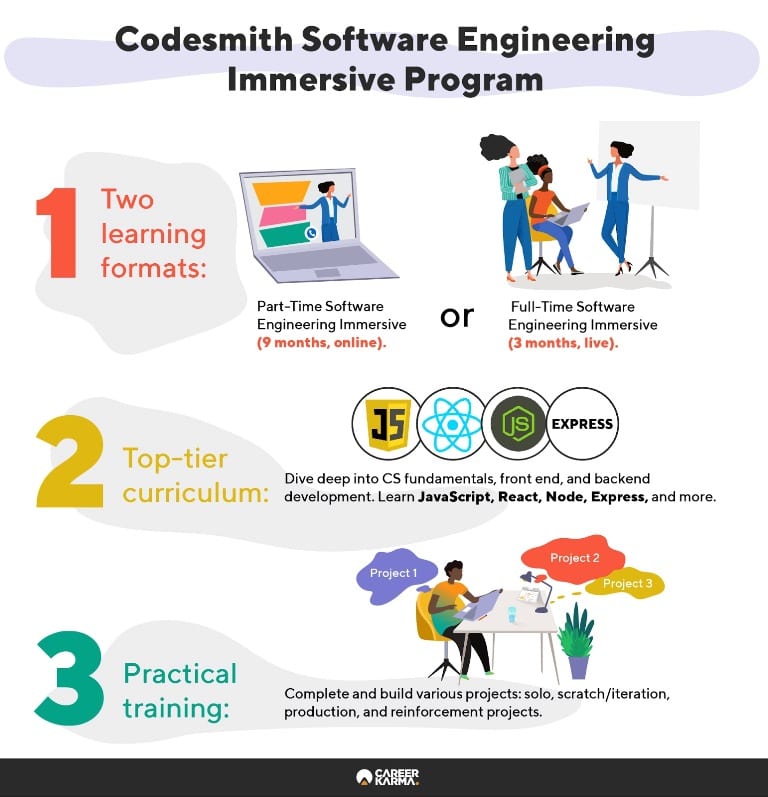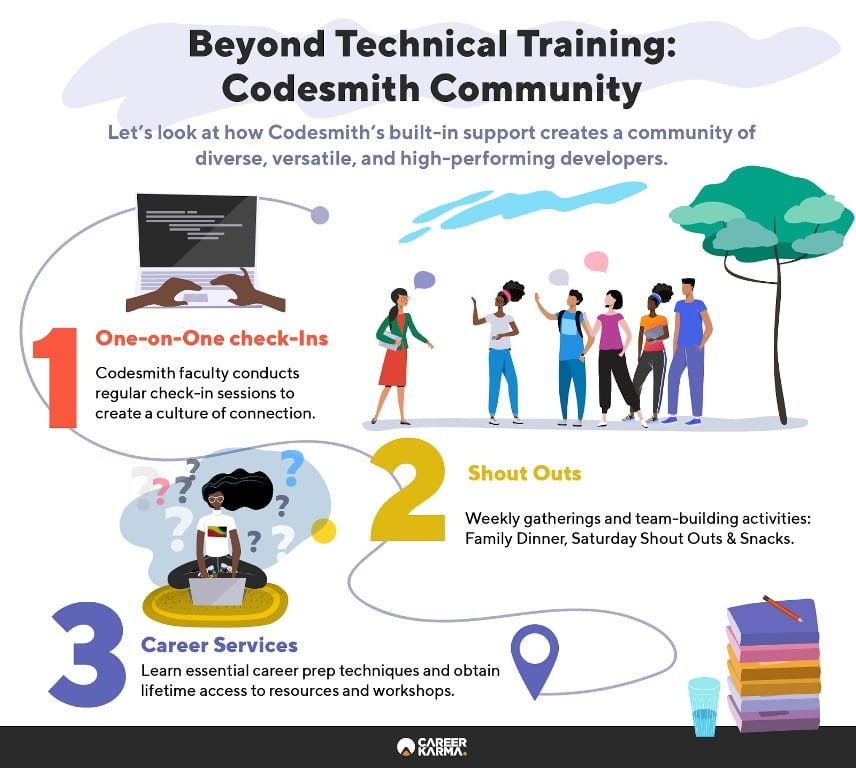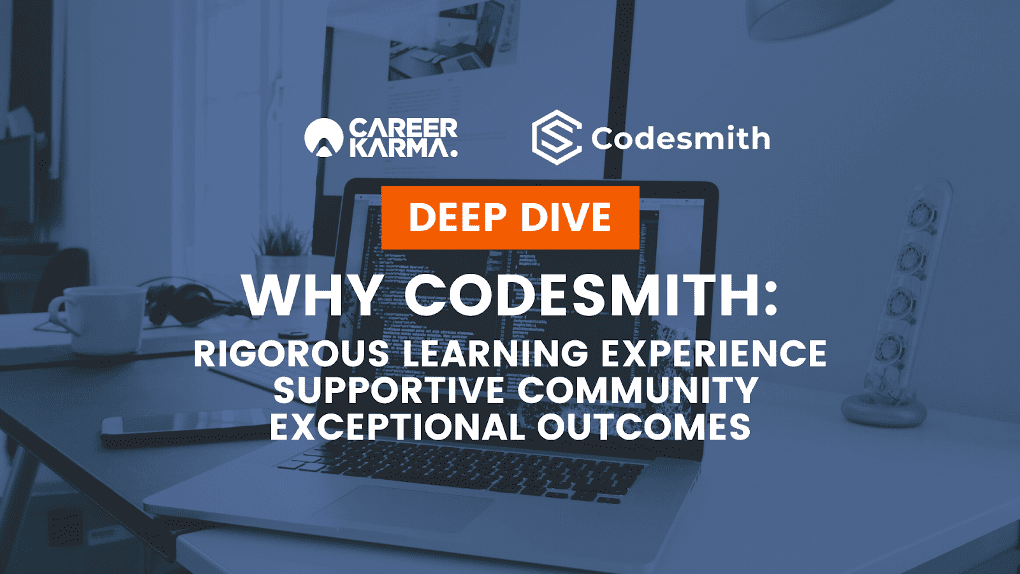A hiring manager walked into a room, settled on her seat, and looked at the three candidates that sat before her. All of them were fresh graduates, each hoping to find a job as a software developer. The hiring manager glanced at the resumes that were laid on her table and opened the interview with the classic question, “Tell me about yourself.”
“I studied computer science for four years and have a strong grasp of the methods, theories, practices, and strategies that fall under the field. I also completed a computer science internship over the summer to complement my coursework,” said the first candidate.
The second candidate followed: “I studied some front-end and backend development, learned multiple programming languages in the process, and developed multiple projects on my own and with my peers. For three months.”
“I fall in the middle,” quipped the third. “Like the second candidate, I trained for three months, learned about full stack development, and tried my hand with the most modern technologies alongside a community of learners. And like the first candidate, I have a deep understanding of the core elements of computer science.”
A week later, the third candidate started her first day at work.
The Anatomy of a T-Shaped Software Engineer
There’s a rare breed of software engineers that are in high demand among employers: the so-called T-shaped engineers. Popularized by IDEO CEO Tim Brown in 2010, the letter T represents two key features.
The vertical stroke of the letter reflects one’s depth of understanding of a particular area. The horizontal bar implies one’s ability to work cross-functionally and think broadly. Put two and two together, and you get a professional who demonstrates expertise in one area while maintaining competency in others.
This is the type of software engineer that coding school Codesmith strives to produce.
From the start, “the goal of Codesmith is to bridge the gap between a CS degree and a coding bootcamp,” said founder Will Sentance.
“You can do this by bringing the most impactful pieces of a CS degree—especially the quality of pedagogy and depth of expertise developed—into the bootcamp format and still have all the benefits of contemporary technologies, career support, and community.”
So, how does this play in practice?
The Prep Stage
Free Coding Events and Workshops
There’s never a shortage of learning resources and initiatives at Codesmith.
If you’re looking to spice up your evenings, learn to code by attending weekly live online workshops and events hosted by Codesmith. These are open to everyone—whether you’re a Codesmith resident, graduate, or just a curious passerby—and are free of charge.
Codesmith’s workshops and events tackle common software engineering workplace problems, like imposter syndrome and the diversity gap, and how to overcome these issues. Coding-heavy workshops like Intro to JavaScript, JavaScript the Hard Parts, and Pair-programming sessions are also widely available.
CSX
The first step to learning is to gain a basic understanding of the field before diving into it. Codesmith makes this possible by offering high-quality learning well before you pay a dime. Enter, CodesmithX or CSX.
CSX is a proprietary online-only learning platform that packs volumes of interactive courses, coding challenges, and workshops that focus exclusively on modern JavaScript.
It was designed with complete beginners in mind, serving as training wheels to help learners become more comfortable and confident with programming. By making the program widely available online, learning how to code becomes only keystrokes away.
While it offers free content, CSX doesn’t lose out on depth. The program has 10 units, each packed with coding challenges. Because it’s a self-paced program, students have the freedom to start from the ground up with concepts like functions, objects, and execution context.
They can also jump right into the more complex topics like callbacks, recursion, asynchronous JavaScript, and object-oriented programming.
CSX’s combination of lectures and coding challenges builds foundational knowledge and skills in software engineering. Its self-paced structure, meanwhile, molds learners into becoming focused and autonomous problem-solvers, both of which are critical to thriving in the world of software.
To support engagement, students gain access to a CSX Slack community. Students can use this space to interact with and learn from fellow learners, reach out to mentors, and connect with a pair programming partner. At the time of writing, the CSX Slack community has over 7,000 members.
JavaScript for Beginners
Codesmith’s JavaScript for Beginners is a step-up from the free CSX course. It comes with guidance, a structured schedule, and a $325 price tag. The program runs for two consecutive Saturdays, during which you’ll cover programming basics and JavaScript principles.
In between, you’ll be assigned multiple coding challenges with a partner to practice your ability to collaborate and work through blocks together. The program caps off with a project-building session where you’ll get to build your very own text-based adventure game.
CS Prep
Need to warm up your tech muscles before committing to an immersive coding school?
CS Prep is a comprehensive primer meant to prepare you for top coding schools like Codesmith, at a cost of $875. If you secure a seat in any of Codesmith’s immersive programs, your CS Prep tuition carries over to your full-time tuition.
The CS Prep program runs for two weeks. During this time, you’ll cover four modules: JavaScript fundamentals, intermediate JavaScript concepts, computer science fundamentals, and engineering soft skills.
The program culminates in a project, where you get to build a web application from scratch using the JavaScript principles you learned throughout the program. Although the program is short-term, it spends enough time covering the basics of JavaScript and equipping you with the engineering toolkit you’ll need to keep up with premier coding schools.
After taking any of these programs, it’s time to take the training wheels off.
Immersive Training
Immersive training at Codesmith requires adopting a T-shaped mentality. This means focusing on computer science and software engineering as well as in areas adjacent to these disciplines. That extends to nontechnical competencies that are relevant to becoming high-performing engineers.

Codesmith Software Engineering Immersive Program
- Cost: $19,350
- Duration: 12 weeks (full-time), 38 weeks (part-time)
1. Two Learning Formats
Coming in with a $19,350 price tag, Codesmith’s Software Engineering Immersive Program can be learned in three ways: full-time live, full-time online, or part-time online.
The Full-Time Software Engineering Immersive runs three months and works best for Codesmith residents (that’s the title Codesmith gives to its students) whose main priority is finishing the course quickly with a fast-tracked schedule.
Codesmith offers the full-time program in person in Los Angeles and New York City, as well as remotely. Note that Codesmith’s LA and NYC programs are temporarily online in light of the COVID-19 pandemic.
The Part-Time Software Engineering Immersive lasts nine months and is ideal for working professionals and parents who need more flexibility in their schedules.
Despite the differences in pace and schedule, both formats offer a rigorous curriculum that requires a high level of commitment and discipline.
2. Codesmith Software Engineering Curriculum
Codesmith’s Software Engineering Immersive curriculum opens the class by diving deep into the fundamentals of computer science. In a matter of weeks, you’ll learn the topics typically covered in a four-year computer science degree, from data structures and algorithms to system design and programming paradigms.
Breadth complements expertise at Codesmith. After tackling computer science principles, the curriculum launches off to both front-end and backend development. In these modules, you’ll learn how to deliver a great user experience and build scalable applications.
These involve learning the latest JavaScript syntax and using the latest technologies like React, Node, Express, relational and non-relational databases, and even machine learning.
It’s not all technical skills at Codesmith. Throughout the program, you’ll develop a keen understanding of real-world software engineering practices through the challenges you’ll encounter along the way—solo and especially with a partner.
You’re not a true Codesmith resident until you’ve done pair programming. Because collaboration and technical communication are central to software engineering, Codesmith education assigns a high value to pair programming.
Expect to get involved in discussions, point out possible bottlenecks, learn how to better value the work of others, and understand what goes on under the hood of software.
3. Codesmith Projects
Projects underscore Codesmith’s commitment to delivering hands-on, practical training. From the beginning until the end, you’ll find yourself building open-source tools that compel you to apply the principles, theories, and skills you’ve learned along the way.
- Solo Projects. Codesmith eases you into the field by starting with projects designed to test your ability to work and think independently. Over time, these projects will help build your confidence in working through problems.
- Scratch/Iteration Projects. These projects are conducted in smaller groups and are meant to expose you to collaborative work. This includes adapting to Agile and Scrum methodologies and using complex technologies to deliver a project to specifications.
- Production Project. Known as the most difficult leg of Codesmith’s project-building series, the production project compels you to build solutions for real-world problems. Projects built in this stage have received praise on Github and in renowned conferences.
- Reinforcement Project. Choose the technology you wish to work with on your first job as a software engineer, and use this to build a scalable application. Then, present your project to companies that use the same technology. This project is more intentional as it gives your prospective employer tangible proof of what you can accomplish.
Beyond Technical Training: Codesmith Community
Codesmith creates a community of diverse, versatile, and high-performing developers not just through the rigorous training it provides but also through its built-in support. After all, learning is not entirely dependent on intellectual elements. Emotional factors also come into play.
With Codesmith residents wrestling with new and complex ideas, they’re bound to need guidance and support.

One-on-One Check-Ins
The Codesmith faculty conducts regular and individual one-on-one check-ins with residents. These sessions seek to create a culture of connection and feedback that permits faculty members to listen to and address the learning concerns and struggles of residents.
Ultimately, the one-on-one check-ins serve both parties. They inform one another about how they can work together to improve the classroom experience.
Shout Outs
Codesmith ensures that every resident feels at home by making time for small gatherings and team-building activities. Every week, onsite residents and team members hold a Family Dinner while residents learning remotely sit down for Saturday Shout Outs & Snacks.
While called differently, both activities are a time for participants to acknowledge everyone’s hard work and motivate one another. These sessions forge that sense of bond, trust, and community that can’t be learned from the dry passage of a textbook or endless lines of code.
Career Services
To train under pressure is one thing. To put yourself out there for the scrutiny of employers is another. Codesmith steps in by providing job search support from as early as the second half of the program. The Codesmith team helps you master the following:
- Learn how to write your resume, create your online profile, and reach out to prospective employers the right way.
- Practice your problem-solving and coding skills for the whiteboarding and technical interviews.
- Approach salary negotiations with the right mindset and strategies.
Once a Codesmith resident, always a Codesmith resident. Long after you graduate, you’ll still have access to the school’s learning resources, workshops, and alumni Slack channel. These are especially vital if you ever need to refresh or update your engineering tool kit or need help negotiating a job offer.
Codesmith Review: Is It Worth It?
It would be remiss for us to answer this question without having strong and factual evidence to support our answer. So, let’s look at the outcomes.
Codesmith sets the bar high for software engineering training, and it seems to do the same for its job placement outcomes. Independently audited by the Council on Integrity in Results Reporting (CIRR), Codesmith’s outcomes showed the strongest performance among coding bootcamps in 2019.
According to its outcomes report, Codesmith had the most number of graduates to land full-time employment as software engineers. Codesmith graduates also had the highest median starting salary, with some even securing mid-level software engineering roles.
So, is Codesmith worth it?
Codesmith is perhaps one of the few coding schools that place a strong emphasis on improving the technical and nontechnical competencies essential for, not just entry-level, but mid- and senior-level software engineering roles.
Think you can commit to Codesmith education? Explore Codesmith and the programs it has to offer. Master the skills you need to become a software engineer to a T.
About us: Career Karma is a platform designed to help job seekers find, research, and connect with job training programs to advance their careers. Learn about the CK publication.




